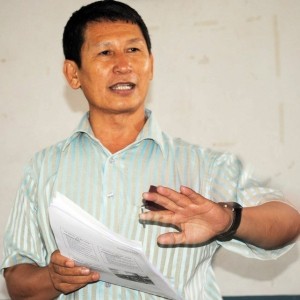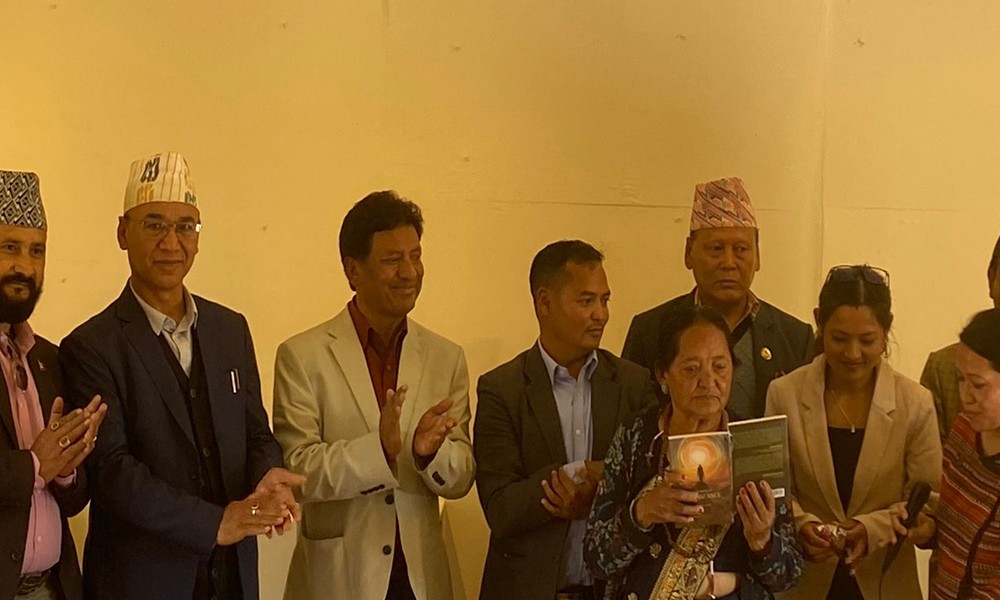Numerous of examples are available globally that the states were formed on the basis of language especially the multilingual countries like Nepal.
In India, out of 26 federal states, 12 states were formed on the basis of language, such as Asam, Gujarat, Mizoram, Karnataka, Maharastra, Manipur, Udisha, Panjab, Rajsthan, Tamilnadu, Tripura and West-Bengal.
It is well-believed that in the state which is formed on the lingual basis, there is good governance, insurance of civil liberties and development of language, literature and knowledge. Therefore, Nepal also can learn the lesson from others and make language a basis while federating the provinces, which will to some extend address the sentiments of multilingual, multi-cultural and multi-ethnic communities in Nepal.
On 9, Dec. 2009, referring the formation of a separate Telangana state in India, a politician and former Home Minister, P. Chidambaram stated that human beings form the identity on the basis of their language and literature. And, therefore, the formation of language on the basis of language will not merely address the sentiments of people but equally help flourish the democratic norm, value and democratic governing system.
An Indian Historian and famous writer, Ramachandra Guha in his book, 'India after Gandhi' writes, 'the politics based on the religion lead to disintegration, but the politics based on the language will lead to the development of regional and local language, literature, knowledge and avoid a fear of formation of another new Pakistan.
Account of state formation in India
Initially, the British, who colonized India, did not allow formation of state on the basis of language. But prior to independence, Indian had started demanding the formation of state on the basis of language.
In the year 1895, in the leadership of a freedom fighter Madhusudan Das the movement was initiated for formation of state on the basis of language. And, in the year 1936 they were successful to form an autonomous state—Udisha. Even after independence, many states were formed on the basis of language but the movement continued. Potti Sreeramulu took fasting demanding to declare Andra Pradesh an autonomous state, on the basis of language. He died during fasting for statehood in the year 1952.
In India, out of 26 federal states, 12 states were formed on the basis of language, such as Asam, Gujarat, Mizoram, Karnataka, Maharastra, Manipur, Udisha, Panjab, Rajsthan, Tamilnadu, Tripura and West-Bengal.
Right after his death, in the year 1953, the Indian government formed a State Reorganization Commission in leadership of Fazal Ali. The commission submitted its report to government in 1955. Based on the recommendation made by State Reorganization Commission as many as 20 states were formed. Pakistan which was formed a state based on the religious was disintegrated from India in 1971 on the basis of language. Similarly, the there was disintegration between Pakistan and Bangladesh on the basis of Urdu language.
In Nepal
The first Constituent Assembly (CA) from 2008 to 2012 had in-depth discussion for taking language as a basis of federating the provinces in Nepal. The language was first basis discussed and listed by the CA members. Right before the CA-election-II, after returning from India visit, the Chairperson of UCPN-Maoist, Puspa Kamal Dahal, referring the suggestions of Indian government, he had stated that language can be a basis of federate provinces.
Number of states on language
In my views, the basis of formation of states on language basis can be taken as follow:
1) Languages which are spoken by more than 1 percent.
2) Continuity of huge settlement of language speakers.
3) Historical presence.
There are as many as 14 languages spoken by more than 1 percent population, but only 11 languages have gained continuity namely—1) Nepali (along with khas language), 2) Bhojpuri 2) Tharu 5) Tamang 6) Newar 7) Magar 8) Awadhi 9) Limbu 10) Gurung 11) Rai-Khambu. All of these languages have chunk of speakers in some specific geography and they have been listed in the National Census right from the first National Census Report to the latest (1954-56 to 2011-2012).
Thus, autonomous states can be formed, within the federal provinces, based on the population of language speaking population up to 0.1 percent, self-ruled states for the population having less than 0.1 percent, and protected areas can be formed for those which have 0.01 percent language speaking population residing in the particular territory.
Based on this analysis, as many as 9 autonomous states can be formed based namely on Banjika, Urdu, Rajbansi, Sherpa, Santhal, Chepang, Danuwar, Sunuwar and Uranw/Jhagad/Kushbadia.
While on the basis of language speaking population having less than 0.1 percent, there can be 22 self-ruled states namely—Majhi, Thami, Bhujel, Yakkha, Dhimal, Tajpuria, Kumal, Darai, Yolmo, Bote, Ghale, Lapcha, Aathaparia, Thakali, Jirel, Meche, Chhantyal, Raji, Chhintal, Gangai, Pahari and Lhopa.
Based on the language speaking population having 0.01 percent, there can be as many as 26 protected areas namely—Dura, Koche, Chhiling, Dolpali, Hayu, Tilung, Koyi, Walung, Musalman, Lhomi, Sonah, Byasi, Sauka, Khamchi (Raute), Saam, Manange, Phangduwali, Surel, Malpande, Khadiya, Baram, Lingkhim, Kagate, Bankariya, Kaike and Kusunda. But, in practice, the number of this protected can be lesser in number than this.
As many as 26 language speaking population which have been listed in the National Census Report are scattered across Nepal, don’t have settlement in any particular location. Those languages are namely are—Hindi, Magahi, Rajesthani, Bangla, Aangika, Sign (language), Tibetan, English, Sanskrit, Hariyani, Panjabi, Udiya, Shindhi, Aasami, Dhuleli, Chinese, Kurmali, Sadhani, Jhonkha, Gadwali, French, Mejo, Kuki, Russian, Spanish and Nagamiz.
Provinces on the basis of ethnicity
It doesn't mean that federal provinces cannot be formed on the basis of caste or ethnicity. There are as many as 18 caste/ethnic communities in Nepal having population above 1 percent of the 26, a total population of the country. But according to National Census Report, it is impossible to form a provinces based on the caste/ethnicity. The ethnicity namely—Magar, Tharu, Tamang, Newar, Rai, Gurung and Limbu, who make the majority and can be formed provinces on these aforesaid ethnicity, as they have history and geographical presence.
But, it is impossible to form federal provinces on the basis of caste namely Chhetri, Bahun (hill), Thakuri, Kaami, Damai, Saarki, Teli, Chamar/Harijan and Koiri/Kushwah. As these language speaking population are scattered, neither do they have historical continuity, nor do they have a fixed settlement in one particular location.
The population having more than 1 percent population namely Chhetri, Bahun (Hill), Thakuri, Kami, Damai and Sarki are Nepali speaking communities, while Teli, Chamar/Harijan and Koiri/Kushwah are Maithili, Bhojpuri or Awadhi speaking population.
Therefore, language can be the one of the prominent basis of federating not merely the provinces, but also other autonomous and protected areas. The language is not merely the identity alone but also the means of maintaining social harmony. The lesson of India and many other states around the globe is that they have good governance, the language and literature are well developed and well-maintenance of peace. If it to make lesser number of provinces, the alternative is that 2 or more languages can either be combined.
SN | Caste/ethnicity | Population | percentage | position | language | no. of population | percent | language used as second language |
Total | 125 caste/ethnicity | 26,494504 | 100 |
| 123 language | 26,494504 | 100 |
|
1 | Chhetri | 4398053 | 16.60 % | 1 | Nepali | 11826953 | 44.63% | 8682499 |
2. | Bahun (hill) | 3226903 | 12.17 | 2 | Maithali | 3092530 | 11.67 | 195287 |
3. | Magar | 1887733 | 7.12 | 3 | Bhojpuri | 1584958 | 5.98 | 159518 |
4 | Tharu | 1737470 | 5.56 | 4 | Tharu | 1529875 | 5.77 | 84748 |
5 | Tamang | 1539830 | 5.81 | 5 | Tamang | 1353311 | 5.10 | 33450 |
6 | Newar | 1321933 | 4.99 | 6 | Newar | 846557 | 3.19 | 32594 |
7 | Musalman (Muslim) | 1164255 | 4.39 | 7 | Banjika | 793416 | 2.99 | 60863 |
8. | Kami | 1258554 | 4.75 | 8 | Magar | 788530 | 2.95 | 42952 |
9 | Yadav | 1054458 | 3.98 | 9 | Doteli | 787827 | 2.97 | - |
10 | Rai | 620004 | 2.34 | 10 | Urdu | 691546 | 2.61 | 45766 |
11 | Gurung | 522641 | 2.34 | 11 | Awadhi | 501752 | 1.89 | 45428 |
12 | Damai/Dholi | 472862 | 1.78 | 12 | Limbu | 343603 | 1.29 | 22.202 |
13. | Limbu | 387300 | 1.46 | 13 | Gurung | 325622 | 1.22 | 22834 |
14 | Thakuri | 425623 | 1.60 | 14 | Baitadeli | 272524 | 1.02 | - |
15 | Sarki | 374816 | 1.41 | 15 | Rai | 159114 | 0.60 | 17199 |
16 | Teli | 369688 | 1.39 |
|
|
|
|
|
17 | Chamar/Harijan | 335693 | 1.27 |
|
|
|
|
|
18 | Koiri/Kushwah | 306393 | 1.15 |
|
|
|
|
|
Others | 107 caste/ethnicity |
|
| Others | 107 languages |
| 100 | 100 |
Source: based on National Census Report 2011, above 1 percent population of caste/ethnicity and language speaking population : Amrit Yonjon, 2014 | ||||||||







